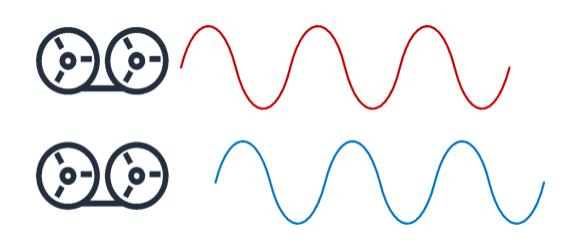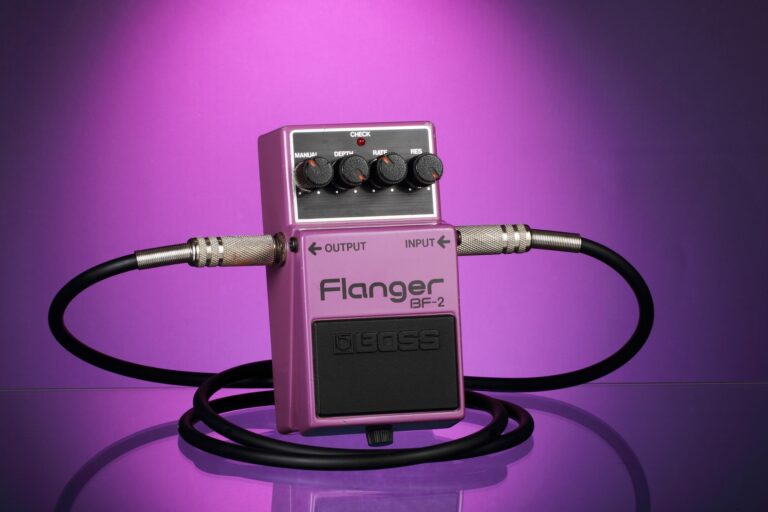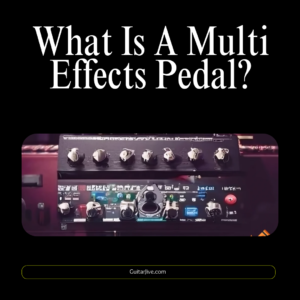Introduction
You may be asking yourself “What the heck is a flanger?” People can go on and on about how much they love the flanger effect and why they need a flanger pedal. But unless you’re educated on what a flanger pedal is, it doesn’t do much good. And this is the reason for this post: to explain the answer to the question, what is flanger?
What is flanger? History of the Flanger Pedal
The flange effect or “flanging” is what you get when 2 identical tracks are played at the same time. One of those tracks is time delayed ever so slightly at around 20 milliseconds.
Now, you might have heard of Les Paul, well he didn’t just make guitars. The flange effect is credited to him for its invention. During the 1950’s he was experimenting with phasing tones in and out and stumbled upon the concept. He recorded the song “Mammy’s Boogie” using the effect. The name “flanger” or “flanging” refers to the method whereby 2 tape reels were played and the speed of one would be slowed down or sped up by pressing on the flange. This was a technique used by John Lennon from the Beatles in the 1960s. This was at the time the only method of creating the sound. It wasn’t until the 1970s that dedicated circuits could be made to recreate the effect.
How Flanger Pedals Work
If you imagine the guitar track recorded on 2 tape reels and played at the same speed and at the same time, the output would be 2 identical sine waves that arrive at the listener’s ear at the same time and in phase. If one of those is delayed slightly then the cycle of the sine wave would be out of phase with the other one, when it arrives at the listener’s ear. This is the effect that flanger pedals are trying to recreate.

The concept of how this is achieved is by splitting the input signal into 2 halves. The first signal is sent to the output, whilst the second is sent through a delay circuit which in turn is controlled by an LFO (Low Frequency Oscillator). This delays our signal, similar to slowing the tape. Part of the delayed signal is then fed back into the delay circuit. This introduces harmonics into the signal (if you don’t know what harmonics are check out my fuzz post, there’s a good graphic there). The two signals are then mixed back together at the output.

How To Use a Flanger Effects Pedal
Rate / Speed
This control is used to set the cycle speed of the LFO, how fast it oscillates. This is what controls the delay time of the circuit.
Depth
This is what controls the amplitude of the LFO’s signal. Generally, these 2 controls will be used together. Often best results are obtained by setting the rate to slow and the depth high or vice versa. Think slow and deep or fast and shallow.
Sweep / Manual
This sets the frequency range of the flanger circuit. By altering the control you are selecting the mid-point through which the filter will sweep. The lower it is set the deeper the sound you’ll end up with. The sweep control should be used in conjunction with the depth control, having the depth too high will have no effect on the sweep.
Feedback
This controls the feedback element of the circuit. How much of the delayed signal is fed back into the delay. The more feedback you have, the more of that flanger “swooshing” sound you’ll have in your sound.
Mix / Blend / D-F-V
This controls the ratio of how the 2 signals are mixed back together at the output. All the way from just having your dry signal, to a purely 100% flanged effect. A good rule is to set this to the middle position so that you have a 50/50 split and then adjust to taste.
Flanger Pedal Examples
Now you’re aquatinted with the flanger effect, it’s time you tried one. There are many types of flanger pedals on the market. TC Electronic produces the “Vortex” which is a great example, it comes with a switch that allows you to select either a classic tape reel flange effect or a modern effect. Boss produces the “BF-3 Flanger” which is the iconic purple one you’ve probably seen around on many pedalboards. I’ve also had great success using the Mooer “MFL1 Electric Lady” analog flanger effects pedal, which has a simple 3 control layout.
Conclusion And Closing Thoughts
Flanger pedals are a classic in the world of guitar effects pedals. They have been popular for decades although one of the most underused modulation effects today. Whether you’re using it to add some sharp attack to your tone or trying to recreate that Who ‘Baba O’Riley’ guitar tone, a flanger is a great tone-shaping tool. I hope you’ve learned something from this guide. Feel free to leave any comments or questions below!





Pingback: The Great Distortion Vs Overdrive Debate: What Is The Difference?
Pingback: What Is Fuzz? The Ultimate Explanation Of Fuzz Effects Pedals
Pingback: A Beginner’s Guide to Guitar effects pedals. | Guitar Jive